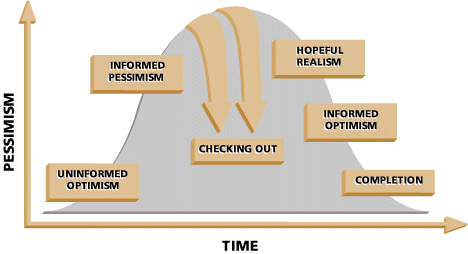Another Reason Why Companies Resist Change
The presentation appeared to be going very well. As the process redesign team unveiled the new set of revenue-accounting processes to its peers and to the first-level accountants, the discussion in the room had been surprisingly positive--everyone seemed to agree that the old combination of patchwork processes and ancient technology was badly in need of repair. The questions centered more on the "how" of the new processes than the "why," and the team was already looking ahead to its next presentation.
But near the end of the meeting, a staff accountant raised his hand. He held up a floppy diskette and said, "I have two spreadsheets on here that I update and distribute twice a month. You haven't told me what I'm supposed to do with these analyses, so I can't really accept any of your recommendations."
The presenter suffered an immediate loss of credibility, and the meeting ended with an admonition to the redesign team to "Go back and get it right."
We have all struggled with major change initiatives such as business process redesign and the implementation of new information technology. What can we learn from this example?
Most senior managers forget a critical principle of change management: Organizations don't change; people do. We tend to think of our change initiatives in broad terms--"We are redesigning the revenue accounting process." Our employees think of it differently--"Do I keep creating this spreadsheet or not?" To implement sustained change, we must translate our initiatives to implications for each individual who will be affected. This is a key reason why change programs always take longer than we think they will.
And when we speak of individual change, the discussion must turn to resistance. In this article, we want to share lessons learned about resistance from organizations that consistently deliver their major change projects on time, within budget and with full capture of the benefits they had forecast.
Lesson #1--Resistance is inevitable. Many managers naïvely assume that if people like a change or think it is a good idea, they will not resist it. Significant change is a disruption in our expectations about the future. This disruption causes a loss of control, and we will resist this loss of control--even if we think the change is a sound one.
Lesson #2--People will express resistance differently based on how they perceive the change. The distinction is whether or not they like the change. Figure I shows the positive case--the way people resist when they view the change as a good idea. Marriage is a good example to illustrate this point.
FIGURE I
MANAGING POSITIVE RESPONSES TO CHANGE 
© ODR, all rights reserved, 1995
At this point, there is a danger of "checking out," represented by the two downward arrows. Public checking out may be, "I want a divorce," while private checking out reflects a superficial calm covering undiscussed conflict and resentment.
If we can manage past this phase, we can reach "hopeful realism"--a view of the light at the end of the tunnel based on a true understanding of both the costs and the benefits of the change. This gives way to "informed optimism"--a sense that the change is achievable and that a great deal has been accomplished already. Finally, the change can be viewed as completed.
Organizational changes often progress the same way--think of the excitement that immediately follows the announcement of a major merger and how that can give way to a realization that the promised "synergy" just doesn't exist.
Figure II shows the negative case--the way people react when they view the change as a bad idea. It is based on the work of Dr. Elisabeth Kübler-Ross and her 1969 book, "On Death and Dying," which identified the stages that terminal patients go through. These stages can be adapted to our organizational change projects:
FIGURE II
MANAGING NEGATIVE RESPONSES TO CHANGE 
© ODR, all rights reserved, 1995
- Stability--This phase precedes the announcement of the change and represents the status quo.
- Immobilization--The initial reaction to a negatively perceived change is shock. The change may appear to be so unreal that the person can't even fathom it.
- Denial--"If I ignore it, it will go away." The person is hoping the change project is not real.
- Anger--This phase is characterized by frustration that often becomes real and directed at other employees.
- Bargaining--Here, people begin negotiating ways to minimize the impact of the change. These might include requests for deadline extensions, modifications to the change initiative or even reassignment.
- Depression--Once the bargaining has failed, a person often gets depressed at the realization that the change is real and permanent. On the plus side, this represents the beginning of acceptance.
- Testing--Similar to bargaining, except that the person is accepting the change and figuring out how to succeed under new conditions.
- Acceptance--Completion of the change.
Lesson #3--Resistance can be overt or covert. In the example above, our accountant was expressing overt resistance. He displayed some courage in speaking out against the change in a meeting of peers and superiors, especially since the presentation was going forward so well. Far more dangerous is covert resistance. We have all been in meetings where people agree with a change and congratulate each other on the group's collective wisdom--only to watch them go back to their offices to tell their peers what a dumb idea they have just wasted time discussing. This covert resistance is impossible to manage, because it can't be confronted.
Lesson #4--What they say may not be what they mean. Recall that our reaction to change is governed by our perceived loss of control. However, we are rarely comfortable expressing honest emotions in a corporate setting. As a result, our accountant who disagreed with the analysis based on omission of his spreadsheets may really be saying, "I knew how to play by the old process rules, and I'm scared that I may not be as successful under the new process." So, even if we address the stated issue (the spreadsheets), we might not be addressing the real cause of his resistance.
Now what?
The key to managing resistance is sincere selling. This approach addresses all the issues we have raised about resistance:
- It recognizes the inevitability of resistance, so it addresses resistance honestly and consistently.
- It acknowledges that resistance will be experienced differently based on positive or negative reactions to change.
- It reflects how resistance can be expressed overtly or covertly and advocates that overt resistance be encouraged, to get problems out in the open.
- It warns that people may not be comfortable expressing their true reasons for resistance and encourages creating an atmosphere that allows honest communication.
In the early stages of a change project, when enthusiasm is high, sincere selling helps minimize the impact of uninformed optimism with a true accounting of what the likely costs of the change will be. While this may cause many change projects to die on the drawing board, that is a better outcome than having the project fail in implementation.
Also, the "sincere seller" will work on team communication to insure that employees understand what the change project entails and feel comfortable expressing honest resistance openly. This level of communication will also enable managers to understand whether employees are having a positive or negative reaction to the change.
Finally, sincere selling means that throughout the change process, we are consistently working with employees to help them understand the individual implications of our change initiatives so that we can recognize the resistance, surface it, manage it and get it behind us.
The accountant's story has a happy ending. As it turns out, the real concern was that the new information technology would make his job redundant. Once he understood that his analyses would actually become part of the new technology--and that he would get enough training to be successful--the resistance disappeared. ![]()
Reprint No. 96101
Many of the ideas in this article are adapted from "Managing at the Speed of Change" by Daryl R. Conner (1992, Villard Books)



